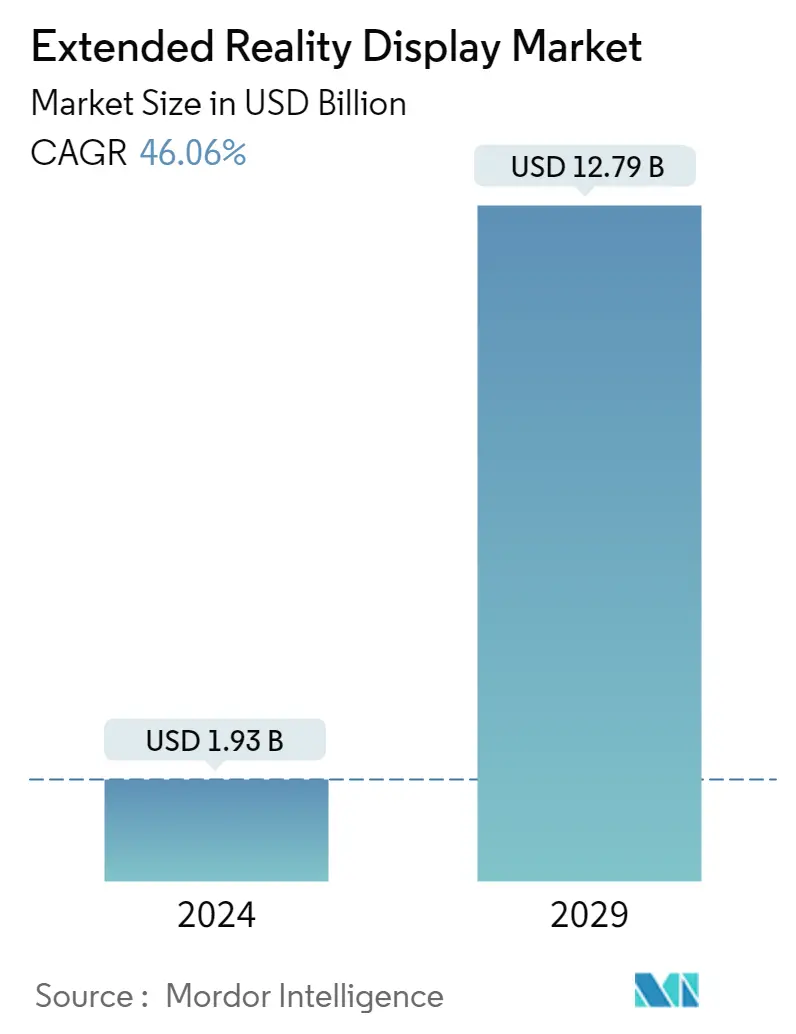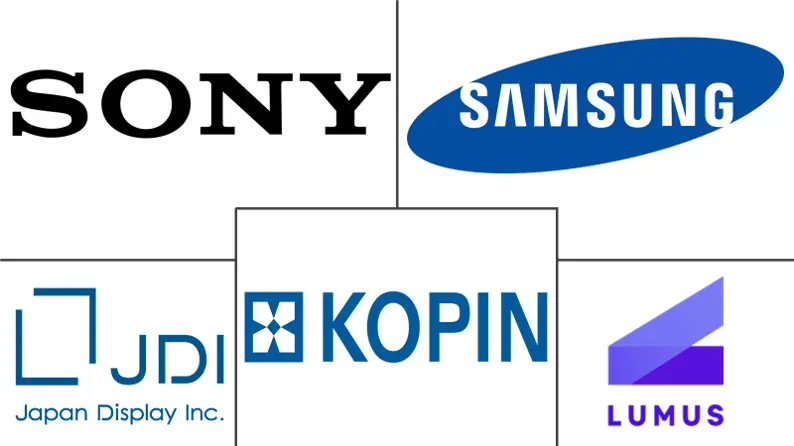Market Size of Extended Reality Display Industry

| Study Period | 2019 - 2029 |
| Market Size (2024) | USD 1.93 Billion |
| Market Size (2029) | USD 12.79 Billion |
| CAGR (2024 - 2029) | 46.06 % |
| Fastest Growing Market | Asia Pacific |
| Largest Market | North America |
| Market Concentration | Low |
Major Players
*Disclaimer: Major Players sorted in no particular order |
Extended Reality Display Market Analysis
The Extended Reality Display Market size is estimated at USD 1.93 billion in 2024, and is expected to reach USD 12.79 billion by 2029, growing at a CAGR of 46.06% during the forecast period (2024-2029).
The onset of the pandemic has triggered the development of extended reality technologies in retail, education, and healthcare. However, the use of XR Technologies has always been dominant in the gaming and entertainment industry despite the impact of COVID-19 that accelerated the adoption of XR technologies in other end-user industries. Thus, driving the growth for displays in the extended reality market.
- The market numbers stated in the study indicate the value of displays sold by the vendors across applications such as gaming, entertainment, retail, healthcare, education, military and defense, automotive and manufacturing, and others. The displays used in the market are designed as either direct view panels or microdisplay panels. The AR display panels are designed as see-through and allow users to view the digital data while fully being aware of the physical world around them.
- The COVID-19 pandemic resulted in an upsurge in adopting XR technologies that drive the demand for displays studied in the market. For example, beauty retailers such as Sephora and Ulta have to forbid customers from physically testing the beauty products on their skin. Beauty retailers are instead turning to AR to help consumers digitally test products to assist in buying decisions.
- Therefore, the use of immersive technology in end-user settings is expected to increase further over the coming years due to the short-term growth in demand augmented by the effects of the pandemic.
- Moreover, Mixed reality adoption is gaining momentum in various sectors where information availability at the eyesight becomes an added advantage and gives an edge. Microsoft is increasingly focusing on innovating its offering to expand its application field. For instance, in March 2021, Microsoft won a contract from the US Army to produce headsets based on the HoloLens 2 worth USD 21.9 billion. Such developments are further expected to impact the adoption of the technology and drive the need for XR displays studied in the market.
- One of the most difficult challenges faced by the XR technology pertains to educating the wider audience - the broader market. The current applications (for smartphones, tablets, and wearables) are limited to a single user alone. For XR to be more accessible, developing multi-user, uniform, and streamlined experiences is a must. In the current market scenario, the availability of such products is limited, thus acting as a significant challenge to the market's growth.
- In the coming years, real-time rendering and interactive AI, the increasing popularity of immersive experiences, and the proliferation of 5G are expected to transform the theatrical experience and boost the growth of the XR display market. For instance, if the end-to-end latency (delay between the user's head movement and the change of the display in a VR headset) is very high, users can experience motion sickness. To avoid it, VR systems need less than 20ms latency, which a 5G can deliver. Thus, 5G is expected to support the demand for the XR market.
Extended Reality Display Industry Segmentation
Extended Reality (XR) is the collective term used for Virtual Reality (VR), Augmented Reality (AR), and Mixed Reality (MR), as well as all future realities such as technology, might bring. XR covers the full spectrum of real and virtual environments. Extended reality displays include Liquid Crystal Displays, Organic Light-Emitting Diode, Digital Light Projector Microdisplay, and Liquid Crystal on Silicon Microdisplay, among others.
The Extended Reality Display Market is segmented by Display Type (Liquid Crystal Displays, Organic Light-Emitting Diode), End-User Industry (Gaming and Entertainment, Healthcare, Education, Military and Defense, Automotive and Manufacturing, Retail), and Geography.
| By Display Type | |
| Liquid Crystal Displays (LCD) | |
| Organic Light-Emitting Diode (OLED) | |
| Other Display Type |
| By End-User Industry | |
| Gaming and Entertainment | |
| Healthcare | |
| Education | |
| Military and Defense | |
| Automotive and Manufacturing | |
| Retail | |
| Other Applications |
| By Geography | |
| North America | |
| Europe | |
| Asia Pacific | |
| Rest of the World |
Extended Reality Display Market Size Summary
The Extended Reality Display Market is poised for significant growth, driven by the increasing adoption of XR technologies across various sectors such as gaming, entertainment, retail, healthcare, education, and more. The pandemic has accelerated the integration of these technologies, particularly in industries like retail, where AR is being used to enhance customer experiences by allowing virtual product testing. The market is characterized by the development of both direct view and microdisplay panels, with AR displays enabling users to interact with digital data while remaining aware of their physical surroundings. The demand for XR displays is further bolstered by advancements in mixed reality and the proliferation of 5G technology, which enhances the immersive experience by reducing latency.
North America is expected to maintain a dominant position in the market, supported by substantial investments from major technology companies and government initiatives promoting innovation through XR technologies. The region's high technological exposure and resource availability have fostered a robust demand for XR devices. Key players in the market, including Sony, Samsung, and Kopin, are leveraging technological advancements to gain a competitive edge, with numerous partnerships and developments in display technology. These companies are actively working on innovative solutions, such as micro OLED panels and high-resolution displays, to meet the growing demand and enhance user experiences in various applications, from gaming to military training.
Extended Reality Display Market Size - Table of Contents
-
1. MARKET INSIGHTS
-
1.1 Market Overview
-
1.2 Industry Attractiveness - Porter's Five Forces Analysis
-
1.2.1 Bargaining Power of Suppliers
-
1.2.2 Bargaining Power of Buyers
-
1.2.3 Threat of New Entrants
-
1.2.4 Intensity of Competitive Rivalry
-
1.2.5 Threat of Substitutes
-
-
1.3 Technology Snapshot
-
1.3.1 Virtual Reality
-
1.3.2 Augmented Reality
-
1.3.3 Mixed Reality
-
-
1.4 Assessment on the impact due to COVID-19 on the market
-
-
2. MARKET SEGMENTATION
-
2.1 By Display Type
-
2.1.1 Liquid Crystal Displays (LCD)
-
2.1.2 Organic Light-Emitting Diode (OLED)
-
2.1.3 Other Display Type
-
-
2.2 By End-User Industry
-
2.2.1 Gaming and Entertainment
-
2.2.2 Healthcare
-
2.2.3 Education
-
2.2.4 Military and Defense
-
2.2.5 Automotive and Manufacturing
-
2.2.6 Retail
-
2.2.7 Other Applications
-
-
2.3 By Geography
-
2.3.1 North America
-
2.3.2 Europe
-
2.3.3 Asia Pacific
-
2.3.4 Rest of the World
-
-
Extended Reality Display Market Size FAQs
How big is the Extended Reality Display Market?
The Extended Reality Display Market size is expected to reach USD 1.93 billion in 2024 and grow at a CAGR of 46.06% to reach USD 12.79 billion by 2029.
What is the current Extended Reality Display Market size?
In 2024, the Extended Reality Display Market size is expected to reach USD 1.93 billion.

